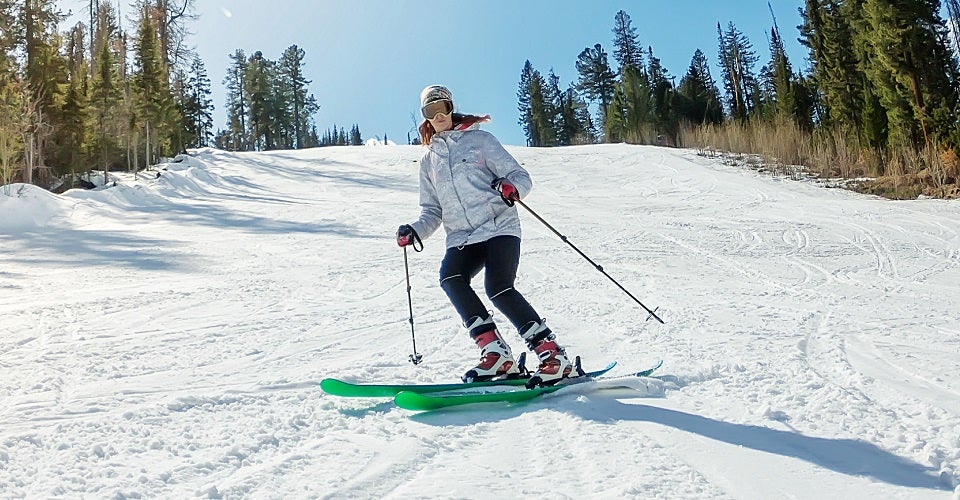
Our Editors independently research, test, and rate what we feel are the best products. We use affiliate links and may receive a small commission on purchases.
When it’s time to hit the slopes, whether it’s your first time or you’re a seasoned pro, you’ll need the right gear. Maybe you need new boots or perhaps you just want to get started with the right gear.
Either way, this article will help you get there.
I’ve spent over 100 days a season teaching skiing to all skill levels. On the mountain, I’ve seen people with new gear, old gear, fitted gear, and hand-me-downs.
There’s no doubt that having the right gear for that fits you properly can speed up your learning and certainly improve your control and handling on the mountain.
Let’s check out the top women’s ski boots today and I’ll help walk you through what to know before you buy.
Best Ski Boots For Women
| Rossignol Alltrack 70 W Ski Boots | Nordica Promachine 95 Ski Boot | Salomon S/MAX 120 W Ski Boots | |
|---|---|---|---|
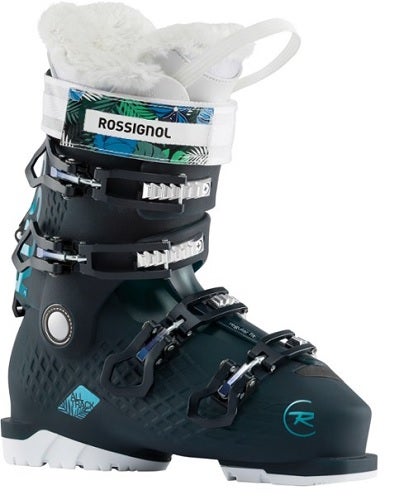 | 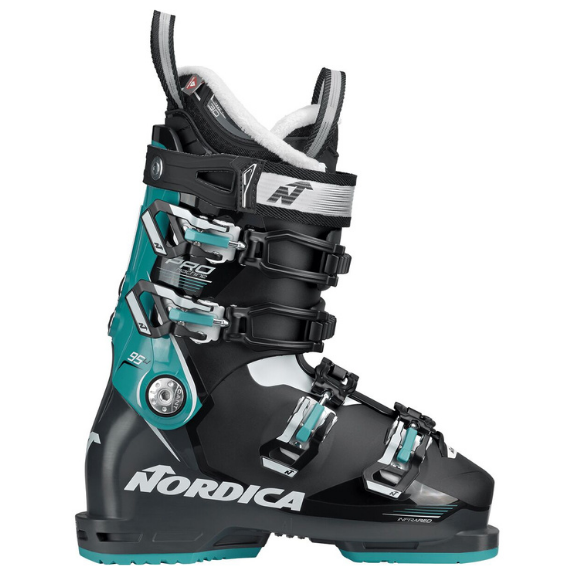 | 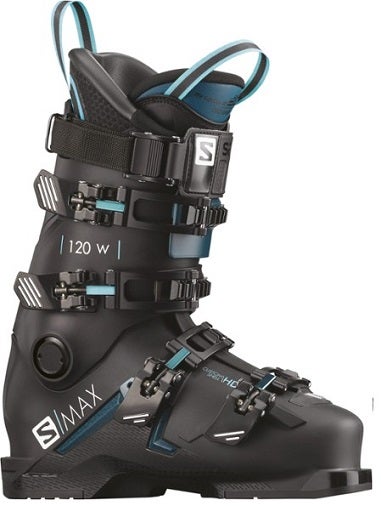 |
|
| Flex: | 70 | 95 | 120 |
| Color: | Black, White | Black, Red | Black, Blue |
| Buckles: | 4 | 4 | 4 |
| Features: | Walking mode | Customizable liner | Thermoformable |
| REI | BackCountry | REI |
For more of my women’s ski gear recommendations, have a look through these popular Outside Pursuits guide links: Women’s Ski Jackets, Women’s Ski Pants, Women’s Ski Gloves.
Quick Answer: The 7 Best Rated Women’s Ski Boots
- Rossignol Alltrack 70 W Ski Boots
- Nordica Promachine 95 Ski Boot
- Salomon S/MAX 120 W Ski Boots
- Dynafit Hoji PX Ski Boot
- Salomon Shift Pro 110 W Alpine Touring Ski Boots
- Scarpa TX Pro Telemark Boot
- K2 Anthem Pro Ski Boot
Womens Ski Boot Reviews
Our reviews of the top rated womens ski boots with our comparison table and guide will help you choose the right pair for you.
Be sure to see our ski boot bags to carry your new boots!
Best Beginner Ski Boots For Women
#1 Rossignol Alltrack 70 W Ski Boots
- Flex: 70
- Color: Black, White
- Buckles: 4
- Features: Walking mode
Let’s kick it off with a soft flex classic ski boot. There’s nothing revolutionary here, but the tried and true is a great place to start.
Let me start by reminding you at a 70 flex is very light. If you’re a beginner, this is great. If you’re lightweight and not particularly tall then a lower flex may be right for you even as your skill level progresses.
That said, the lower flex rating makes these boots super comfortable. Plus, they’ve got a generous boot width (last) at 102mm – another comfort factor. On top of all of that, these boots also rock a “walk mode” which means you can flip a switch to allow the ankles to articulate freely.
Overall this is a solid looker for those who are getting started, prefer lots of comfort, or people who are short/light.
Best Womens Intermediate Ski Boots
#2 Nordica Promachine 95 Ski Boot
- Flex: 95
- Color: Black, Red
- Buckles: 4
- Features: Customizable liner
Nordica is a classic name in the ski world. Their gear is proven, focused, and effective. That’s why they make a spot on our list.
At 95 flex we’re getting a little stiffer so these boots are going to hold up to taller, heavier skiers or those with moderate skills. Remember, the more you flex into those boots the stiffer you’ll want them to be in order to efficiently transfer power into your skis.
As we advance in skill we also need a little finer control over our boots. Each buckle has multiple attachment points (as always) but you can also twist the buckles to screw them in/out for fine adjustment.
We can also tell that we’re moving into a more advanced boot by looking at the smaller 98mm last (width). Don’t worry though, they packed the liner with self-forming cork and the liners are heat-moldable if you take it to a fitter.
Best Womens Advanced Ski Boots
#3 Salomon S/MAX 120 W Ski Boots
- Flex: 120
- Color: Black, Blue
- Buckles: 4
- Features: Thermoformable
Salomon makes some awesome on-piste boots that can really push your game. I think their MAX series is among the best technical boot for non-racers out there.
These boots are rocking a very stiff 120 flex. That’s going to be perfect for skiers who really know how to get forward on their skis and crank down hard on those boots.
On this model they’ve doubled down on the heat-moldable features. The S/MAX model now uses thinner wall construction in specific spots with modern materials to allow an incredibly custom fitting out of the box at any competent boot fitter.
For high-performance skiing they’ve really focused on the Coreframe tech which helps add rigidity and maintain power transfer even with the thinner shell. Plus they’ve designed the cuff and straps around the “Sense Amplifier” concept to add power transmission.
Best Womens Touring Ski Boots
#4 Dynafit Hoji PX Ski Boot
- Flex: “Stiff”
- Color: Black, Blue
- Buckles: 3
- Features: Touring features
Dynafit is one of the hottest brands in recent years. Their gear caters to skiers with deep pockets who like the deep powder.
This boot is loaded up with features aimed straight at the touring crowd. That doesn’t mean you can’t ski it inbounds, though.
As we would expect on a high-end boot it comes out of the box with a moldable liner and shell. You’ll also get micro-adjust buckles to really fine-tune things.
Maybe the only non-performance feature is the very generous 103.5mm last. Let’s be honest though, most ski-tourers spend more time skinning than skiing so that comfort factor and the switchable walk mode will be much-welcomed.
Most Comfortable Womens Ski Boots
#5 Salomon Shift Pro 110 W Alpine Touring Ski Boots
- Flex: 110
- Color: Steel, Black
- Buckles: 4
- Features: Walk mode
Because Salomon really nails their technical design on-piste they’ve lent that expertise to the touring world with the Shift Pro.
If you’re an advanced or expert skier on-piste and you want to take that technical approach into the backcountry then check these out.
Salomon built these boots with your standard touring features. You’ll find tech binding compatibility, rubber boot soles, and a walk/tour mode on the boots. What you’ll also find, however, are a lot of the features from the S/PRO lineup.
Like the S/MAX we talked about earlier these boots are built around a highly thermo-moldable shell and liner out of the box. Integrated with this is the Coreframe buildup which really helps keep that power transmission rocking out.
Best Womens Telemark Ski Boots
#6 Scarpa TX Pro Telemark Boot
- Flex: “Stiff”
- Color: Blue, White
- Buckles: 4
- Features: Walk mode
If you’re going to bend the knee to the gods of tele-skiing then you’re already familiar with the Scarpa brand. Let’s check out the TX Pro.
First, let me say hats off to you tele skiers out there!
It seems hard to find boots these days that don’t have walk mode enabled cuffs so we can expect that out of this boot. You’ll also be able to ski it with your choice of NTN or TLT bindings. More options are always better when it comes to bindings.
You can adjust the cant with an integrated nut on the ankle. It also rocks a women’s-specific liner (as any women’s ski boot should).
On the bottom is a Vibram rubber sole which I would normally dislike in terms of performance, but with tele bindings, you won’t get any added performance from the majority of the boot sole so it’s a moot point here.
The added grip is nice if you end up walking on slick surfaces at the resort. This one does rock a wide 102mm last so it’s going to be a bit roomy.
If you’ve got small feet or you want top-notch, toe-crushing performance you won’t find a fit here.
Best Womens Technical Ski Boots
#7 K2 Anthem Pro Ski Boot
- Flex: 120
- Color: Black
- Buckles: 4
- Features: Adjustable cant
If you’re like me and you want your boots to crank down and transfer even the thought of a turn into your skis then this one’s for you.
I want to just say upfront that these boots are not going to be nice and comfortable. They’re not going to be the right pick for beginners.
With a 98mm last and 120 flex rating these boots are on-piste performance packages for your feet. The narrow last and high flex means you’ll transfer every little movement of your hips, feet, and legs into your skis whether they’re good movements or bad ones.
If you’re ready to push your skills and your skis to their max then you’re ready for a stiff flex, narrow, dedicated groomer boot like this one.
Best for advanced skiers on-piste ripping when you want perfect control over every part of your skis.
Womens Ski Boots Comparison Table
| Womens Ski Boots | Flex | Color | Buckles | Features | |
|---|---|---|---|---|---|
| Rossignol Alltrack 70 W Ski Boots |  | 70 | Black, White | 4 | Walking mode |
| Nordica Promachine 95 Ski Boot | 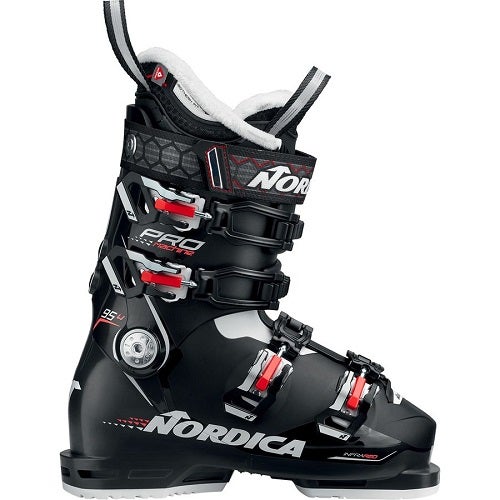 | 95 | Black, Red | 4 | Customizable liner |
| Salomon S/MAX 120 W Ski Boots |  | 120 | Black, Blue | 4 | Thermoformable |
| Dynafit Hoji PX Ski Boot | 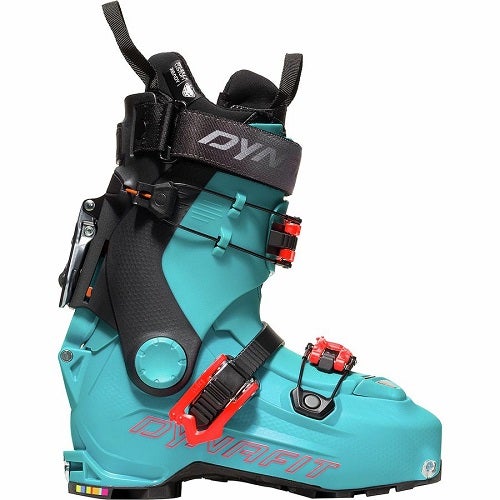 | “Stiff” | Black, Blue | 3 | Touring features |
| Salomon Shift Pro 110 W Alpine Touring Ski Boots | 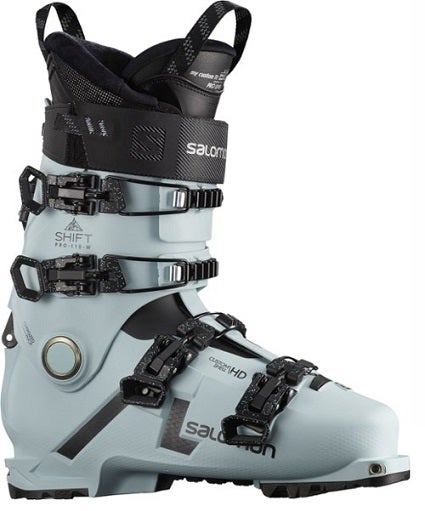 | 110 | Steel, Black | 4 | Walk mode |
| Scarpa TX Pro Telemark Boot | 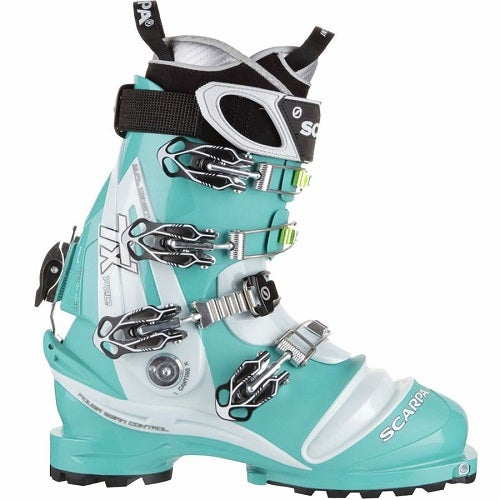 | “Stiff” | Blue, White | 4 | Walk mode |
| K2 Anthem Pro Ski Boot | 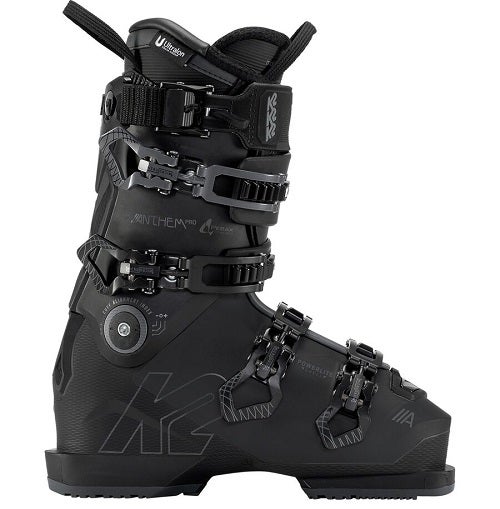 | 120 | Black | 4 | Adjustable cant |
Author’s Expertise / Why You Should Trust Our Reviews
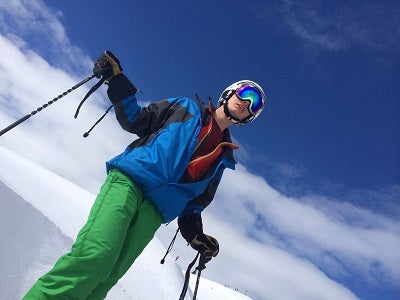
I started writing online for my own outdoor sports blog in 2010. Right out of the gate I landed opportunities to test gear for Road ID, Hydrapak, Wolverine, Helle Knives, Pearl Izumi, and GU Energy. Those were the days when growing a no-name blog was easy. Today niche blogging is a different story.
In 2012 I left Central Wyoming College with a degree in Outdoor Education and Leadership. Soon after, I was on a month-long expedition with the National Outdoor Leadership School’s Outdoor Educator Course which helps would-be outdoor guides ascend from “aspiring” to “inspiring”.
Between here and there I’ve participated in and spoken at length about outdoor pro-deal programs for companies like Patagonia, Smith Optics, Giro, Therm-a-Rest, Platypus, MSR, Columbia, and many more. I still work closely with tons of outdoor gear companies to review and analyze products. If you have a product opportunity you’d like to discuss, please review my guidelines and contact me here.
After several seasons of guiding backpacking trips and working as a certified Alpine Ski Instructor at Deer Valley Resort in Park City, UT for several seasons, I had to move on. As any educator will tell you – teaching doesn’t pay the bills very well.
In 2016 I began building my freelance writing career as readers and other bloggers reached out to me for help with technical outdoor sports content strategy for online businesses. Within weeks I was overloaded with requests for freelance writing and my new career blossomed.
2018 saw the launch of Hike With Less, my ultralight backpacking partnership program with Dustin Walker.
How to Choose the Best Womens Ski Boots
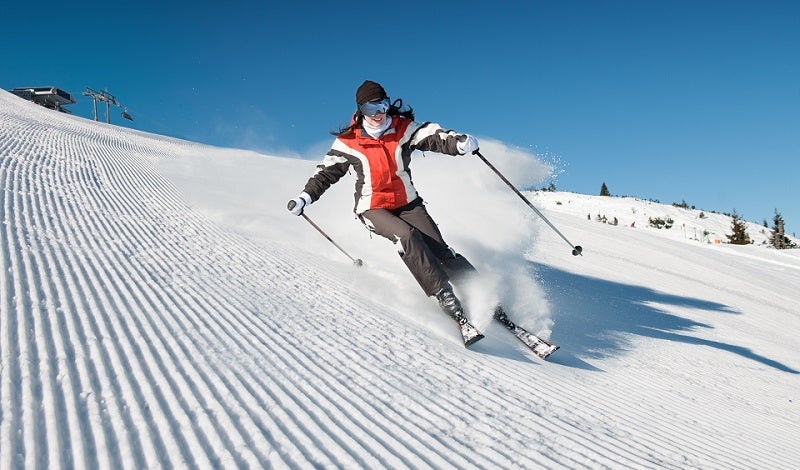
Types of Ski Boots
When it’s time to pick out ski boots, you gotta know what you’re looking at. There are basically three flavors of common ski boots you’ll see on the mountain.
Alpine Ski Boots
Alpine boots, or standard ski boots, are your basic ski boots on the mountain. These boots are meant for any type of skiing that doesn’t involve hiking.
When I say “hiking” I mean skinning up the mountain for backcountry skiing.
Alpine boots are great for every kind of skiing you’ll find at a ski resort or your average ski mountain. They’re awesome for on-piste, racing, skiing bumps, even skiing powder. Anything that’s not touring.
Touring Boots
Modern touring boots are made like alpine boots but they feature a walk mode and are made to integrate with touring bindings.
Ski touring is what people do when they’re traveling in the backcountry and have to climb the mountain using their feet and legs instead of a ski lift.
Touring boots are the modern standard for backcountry skiing and touring of all kinds.
Telemark Boots
Telemark boots, drop knee, free-heel – whatever you call it – are an older standard for backcountry skiing and touring. They’re still popular and very fun!
Telemark boots are different from touring boots in that they lack the ability to be locked down when skiing. Modern touring boots can lock up when skiing downhill whereas telemark boots are free-heeling 100% of the time.
Ski Boot Flex
Flex rating is a number that describes how stiff the shell of your boot is. Ski boot shells are made from a handful of common plastic composites. These composites can be made so that they flex with different stiffnesses.
Ski boot flex ratings usually range from about 60 – 140. The lower the flex number, the softer the boot will be.
Ski boot flex is important to get right for a few reasons.
Stiffer boots transfer more energy and control into your skis better than soft boots. That doesn’t mean stiff is the right way to go for everyone.
Soft boots are good for beginners. They’re more comfortable and they’re easier to “push into the cuff”. Beginners will be able to progress better with softer boots until they develop more advanced skills and control of the fine motor control and body discipline needed for advanced skiing.
Remember that your body is a lever. The heavier you are and the taller you are, the more leverage you have to bend your boots when you push into the front of the cuff (as you should). A tall, heavy, beginner will need stiffer boots than a lightweight, short beginner skier. Over-flexing your boots is a no-no.
If you’re not sure what flex rating is best for you then do yourself a favor – go to a boot fitter and get fitted.
Mondo Sizing
Mondo size is the standard size measurement for ski boots.
What mondo size are you? Well… that’s one of those things you just can’t figure out online. So, what’s to be done?
You’d better get your butt to a boot fitter or outfitter that stocks and sells ski boots. Get measured for your mondo size there and then you’ll be on the right track.
If you absolutely can’t get to a store or if you just refuse to go get fitted then you can use a conversion chart. Please be aware that those conversion charts will get you a rough estimate but it won’t be a perfect conversion.
Buying the wrong size ski boots can get you hurt, promote bad techniques, and/or waste your money when you end up having to buy the correct boots next season.
Ski Boot Custom Fitting
Many of today’s women’s ski boots feature custom fitting in the liners and shells. Out of the box, most of these boots have heat-moldable shells and liners.
Don’t be confused – these aren’t for baking in your home oven. You really need to go to a boot fitter to get these adjusted. Using the wrong temperature or fitting your boots improperly can cause hot spots, uncomfortability, or even just destroy your boots altogether.
If your boots don’t have out-of-the-box customizability, don’t worry! Most boot fitters can custom fit just about any boot on the planet.
Canting and Boot Angle
The boot angle is usually set out of the box but can sometimes be adjusted by a boot fitter or tinkered with by a good boot fitter. Boot angle and cant should be adjusted based on your weight, height, skill, ski type, etc.
This is something you won’t be able to understand for yourself until you’re a relatively advanced skier and have had the opportunity to work closely with a good boot fitter. Unless you’re a dedicated racer, instructor, or die-hard enthusiast you probably won’t worry much about this until it’s time to go to a professional boot fitter.
Ski Boot Last
Last is a technical spec that basically just measures the width of the inside of the boot.
Ski boot last, or width, is important in two main ways. First is comfort. Getting too narrow of a boot for those with wide feet can lead to real fitment issues. Second is control. Having the right width means there’s less (ideally no) room for your foot to “slop” around inside the boot.
Getting the correct last for you is a combination of what you need out of the boot in terms of comfort versus performance. Balance the two correctly and you’ll find the right ski boot last for your needs.
Factoring in Your Skill Level
Beginners need different boots than the pros – period.
Beginners are typically not going to shell out top-dollar. They’ll generally also need a softer flex rating. Uncomfortable boots can scare off (or injure) the beginner skier with hot spots, soreness, and pain. A beginner skier often deserves a more generous last and wider boot sizing for this reason.
Throughout your decision making in choosing your ski boots, skill level should always be a factor.
For instance, a brand new skier on a budget may not care whether or not their buckles have the micro-adjust capability. An expert-level skier, however, is almost guaranteed to want or need this feature.
Remember that, like most sports and skills in the world, what you need depends a lot on your skill level and personal situation. Saying things like, “stiff ski boots are better than soft ski boots” is grossly oversimplifying the situation and failing to take into account everyone’s individual needs.
Be sure to slow down and consider where you’re at personally before taking all the advice that comes your way.
FAQs About Womens Ski Boots
Q: Should I buy used ski boots?
A: Unless you’re experienced enough to know exactly what brand, model, size, and flex you need – then no.
Buying used ski boots can be a total crapshoot. If you’re not familiar with the exact specifications, sizing, and details of the boots you’re about to buy then it’s almost impossible to get a good pick for you.
Now, don’t get me wrong. If you’ve looked all season for some Solomon Extreme X Pro X 1.130’s (made-up boot name) and you find them gently used from a buddy at the ski resort then by all means jump on it!
However, buying some really inexpensive boots from some rando on the marketplace app is almost sure to turn out poorly. Liners can get packed out, they may fit poorly, they may turn out to be a very old model boot that you can’t find parts for, etc.
Starting your adventure in the skiing world buy wasting money on boots that don’t fit you well can be uncomfortable on the mountain and promote poor technique that you’ll struggle to correct as you learn.
Q: What ski boot flex is best?
A: It’s not a question of “good” versus “bad” ski boot flex. Instead, it’s more like “what ski boot flex is right for my needs”?
Here are some really ballpark guesses to get you pointed in the right direction:
Male beginner, lightweight body type: 90-100 flex
Female beginner, lightweight body type: 60-90 flex
Male beginner, heavy body type: 100-110 flex
Female beginner, heavy body type: 80 – 100 flex
If you’re an intermediate or advanced skier or a specialized skier like a racer then you probably already know what flex you’re skiing and whether or not it’s working well for you.
If you’ve been skiing a while and aren’t sure that you’ve got the right flex then please go get fitted.
Q: Should I spend more money on my boots or my skis?
A: Tough question to answer here!
Generally speaking, I would spend my money on boots. Get the right boots for your needs and pay a little extra to go have everything fitted properly for you. Most often I see new skiers struggle more with bad boot or boots that don’t fit than I do with poor skis.
When it comes to skis, most modern entry-level skis are pretty affordable and generally come with pre-mounted universal bindings. For getting started, I’d chuck the extra cash at good boots and proper fitting.
Q: What is the walk mode, or tour mode on my boots?
A: What started as a feature on touring boots to facilitate comfortable climbing became a popular trend that’s very widespread currently.
Touring boots at some point started coming with a lever on the back that could lock and unlock the cuff from free-articulation. This allowed for comfortable range of motion when climbing or skinning and the ability to lock in on the descent.
As you might anticipate this feature was also popular with regular skiers who love the extra movement for comfort when moving around the resort.
Unfortunately, however, I’ve yet to meet any ski boot with “walk” functionality that actually locks in tight. They invariably have some degree of slop when locked down.
Personally, I can’t stand slop in my boots at all. I want my boots to be locked down to the point that even the tiniest movement I make is transferred into my skis directly. Slop introduced by the “walk” modes on alpine boots take away from the performance of good dedicated alpine boots.
Let me be clear – this feature is a must-have for backcountry skiers! However, if you want the best on-piste performance I’d skip right over it.
Q: Do I need custom liners?
A: Possibly.
If you’ve got the budget for it and you’ve reached anything above “intermediate” skill I would recommend custom insoles, liners, and a full boot tuning. You’ll be amazed what kind of difference it makes on the mountain.
If you’re a beginner or if you’ve got a budget then don’t even bother.
There are lots of boots out these days that come out of the box with moldable liners and shells. Usually when you buy boots from any reputable shop they’ll include custom molding out of the box with the price of the boots – no extra cost.
For the majority of skiers these out-of-the-box services will create a near-custom fit that will help a ton. However, there’s no real replacement for getting your boots perfectly punched, ground, fit, and formed to your exact body mechanics.
Conclusion
There are a lot of ski boots out there. There are also a lot of skiers out there. What’s clear is that no single make or model of ski boot is perfect for everyone. You’ll need to think about your own skills, situation, and needs before you make a purchase.
We covered most of the basics of choosing ski boots, but there are many nuances that you’ll learn over time. Nothing can truly replace a good ski instructor and a good boot fitter. When you have the luxury to do so, take some lessons and get fitted.
Until then, check out our list of the best ladies ski boots and use my “how to choose” guide to make a smart pick!
How We Researched
To come up with the best women’s ski boots, we researched a variety of sources for reviews such as REI, Backcountry, Moosejaw, EVO along with our own personal experience.
We also consulted online magazines for product research and reviews to get as much unbiased information as we could. To help weed out fake reviews we used Fakespot.com to make sure we only looked at genuine reviews.
With so much quality gear available, we had to narrow it down based on what we felt were the best options were for the price. The author, Casey Fiedler was a full time ski instructor for Park City and The Canyons in Utah.
To help narrow down the selection he used his personal experience along with recommendations from fellow ski instructors.
After extensive research, we came up with our list to help you choose the right one for you.
Sources
